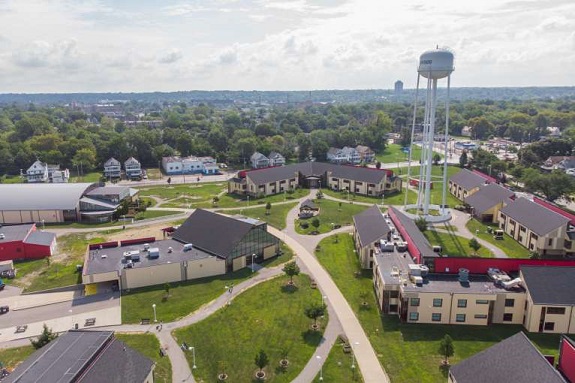Cleveland Job Corps — A Hidden Jewel In Collinwood by C. Ellen Connally!

CoolCleveland.com, By C.Ellen Connally, Posted January 16th 2023
During World War II, Cleveland’s Collinwood neighborhood, located seven miles east of Public Square, was one of the most concentrated industrial areas in the world. Within its boundaries were Fisher Body (a division of General Motors), TRW, Lincoln Electric, Eaton Corp, and Babcock and Wilcox, in addition to the New York Central Railroad yard, which eventually became CONRAIL.
But as the nation’s industrial output began to decline after the war, so did Collinwood. By the early 1980s CONRAIL, Fisher Body and Eaton were shutting their doors, causing the loss of thousands of jobs and putting a serious dent in Cleveland’s economy.
In the early 1980s, the State of Ohio announced plans to purchase the abandoned Fisher Body site and construct a minimum-security jail. Proponents argued that inmates would have closer access to families living in the area and jobs would be created. But neighbors strongly objected, and the plans were eventually scrapped, leaving the land a classic brownfield.
While there are signs of rejuvenation and rebuilding in Collinwood, especially with the help of the Collinwood Village Development Corp. (est. 1987) and more recently the Greater Collinwood Development Corp., a drive through the area still shows startling reminders of what once was, with blocks of vacant and abandoned factories, often littered with debris from illegal dumping.
But among the acres of Collinwood’s industrial past, there is a shining star. It is the Cleveland Job Corps. Located at 13421 Coit Road, on a 25-acre site that formerly housed the Fisher Body Plant, it is truly one of Cleveland’s hidden treasures. Made up of some 30 newly constructed low-rise buildings, the unsuspecting visitor would initially think that it was an upscale housing development or retirement village.

The Job Corps, a child of President Lyndon Johnson’s War on Poverty, was founded in 1964. It is essentially a career training program for low-income youths. Its mission is to help young people to move from their old environments and improve their quality of life through vocational and academic training — all aimed at gainful employment and career pathways.
Originally located in the old Tutor Arms Hotel, on Carnegie, near University Circle, the Job Corp moved to its new location in 2004, when the federal government purchased the land.
Around the country and in Puerto Rico, there are 121 Job Corps centers, and students can enroll in centers near their home or around the country. Since 1964 Job Corps has served more than 1.9 million young people and serves about 60,000 youths annually. Most graduates join the workforce. Some join the military and more than 15% go on to higher education.
Applicants must be U.S. residents who meet low-income criteria, between 16 and 24, not on probation, have no drug problems, or convictions for specific criminal offenses. This is a residential program where students live for a maximum of two years. Students living in the area go home on weekends, others stay until their program is finished. And most important, it’s free — no student loans to pay back.
The Cleveland Campus has a capacity of 350 students but is currently down to 60 due to cutbacks during the pandemic. The campus includes housing, recreational areas, full cafeteria services, computer labs and a wellness center for basic medical needs. To say that I was impressed with the facility is an understatement. It employs about 150 people and according to the staff, there are always openings for people seeking employment in jobs ranging from security guards to teachers and counselors.

Students receive training in such fields as bricklaying, carpentry, EMT training and nursing assistant, in addition to academic training. They can graduate and secure jobs in such fields as construction, finance and business, health care, homeland security, hospitality and information technology, just to name a few. Students who complete the program can anticipate high paying jobs that are often obtained through the assistance of the Job Corps program that places its graduates.
We all complain about high taxes and question what the government is doing for the average person. I am glad to say that I was able to see my tax dollars at work. The facility was modern, well-maintained and secure. Some of the facilities were built by the students. Several of the staff members that I met were graduates of the program and stayed on to train other students who, like themselves, needed a boost.
I gave my presentation in a modern gymnasium, that was adjoined by a state of the art work out rooms, a computer lab and a radio studio. There were healthy snacks available for the taking. The students were well behaved and attentive, and staff made sure that the few that weren’t corrected their behavior. The game room that was on the first floor of the facility was filled with a pool table, and other recreational equipment. The dormitory had rows of washers and dryers for students to do their laundry. There were computer labs in each dorm and areas for physical activity.
After seeing what the Job Corp offers, there is no excuse for low-income students to say that America does not provide opportunities. The site that could have ended up as a prison incarcerating youthful offenders is now a gateway to a better life and a way to achieve the American dream.
Check it out for yourself on a virtual tour at here.
C. Ellen Connally is a retired judge of the Cleveland Municipal Court. From 2010 to 2014 she served as the President of the Cuyahoga County Council. An avid reader and student of American history, she serves on the Board of the Ohio History Connection, is currently vice president of the Cuyahoga County Soldiers and Sailors Monument Commission and past president of the Cleveland Civil War Round Table. She holds degrees from BGSU, CSU and is all but dissertation for a PhD from the University of Akron.








